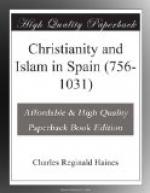[1] Mariana, vi. 9. Pseudo-Luit.
gives the legate the name of
Marinus, and says he was sent
in 932 to Basilius, Bishop of
Toledo.
[2] Cp. the monstrous way in which the Portuguese Roman Catholics, under Don Alexis de Menezes, destroyed the sacred books and memorials of the ancient Syrian Church on the Malabar coast in India.
[3] And I. of Castile.
But the interference of the pope was not confined to matters relating to the Spanish Church at large, his heavy hand fell upon the king himself, and at the end of the twelfth century Alfonso IX. and all his kingdom were laid under an interdict by Celestine III. because he had married within forbidden limits, and refused to divorce his wife at the bidding of the pope. He did in the end divorce her, but only to repeat the same offence with a second wife, Berengaria, and incur the same penalty at the hands of Innocent III. Encroachments on the king’s power went on apace, and gradually appeals came to be referred to Rome from the king’s courts, and the pope took upon himself to appoint to benefices and bishoprics; a usurpation which was countenanced by Alfonso X. (1252-1284).[1] But this result was not attained without remonstrances from the Cortes, and finally, under Ferdinand and Isabella, the question came to an open rupture between the Spanish Court and the reigning pope, Sixtus IV. Isabella, though so ready to submit herself in matters of personal religion to the pope and his legates, refused, like her later namesake of England, to bate one jot of her ecclesiastical rights; and the pope had to give way, contenting himself with the barren power of appointing those nominated by the sovereigns of the land. But if the sovereign was jealous of his rights, no less so were the barons of theirs, and when in the war of the barons with Henry IV. (1454-1474), the papal legate threw his influence on to the king’s side, and excommunicated the rebellious barons, they firmly answered that “those who had advised the pope that he had a right to interfere in the temporal concerns of Castile had deceived him; and that they, the barons of the kingdom, had a perfect right to depose their sovereign on sufficient grounds, and meant to exercise it."[2]
A similarly independent spirit shewed itself in Aragon. In 1213 Pedro II. died fighting against the papal persecutor of the Albigensians, and down to the time of Charles V., the princes of Aragon were at open enmity with the Roman See,[3] and the Aragonese strenuously resisted the establishment of the Inquisition.[4]
[1] Prescott, “Ferd. and Isab.,” p. 15.
[2] Prescott, p. 72. Cp. the charter of Aragon, whereby the king, if he violated the charter of the realm, might be deposed, and any other Pagan or Christian substituted. Ibid, p. 23.
[3] Lockhart, Introduction
to Spanish ballads, p. 9. (Chandos
Classics.)




